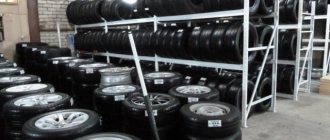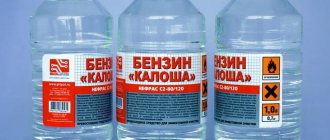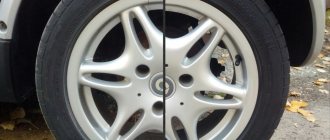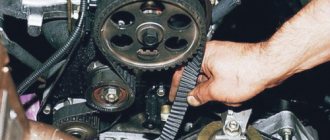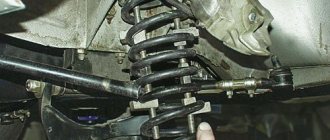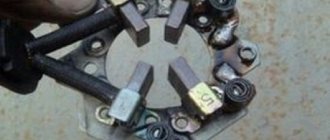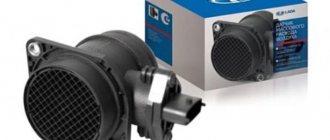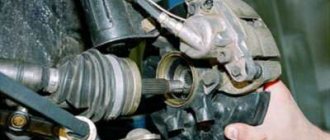Ever wondered how to properly store tires without rims? It would seem that the task is simple: you took off the set in the spring, replaced it with a summer one, and threw the winter one in a pile in the garage and don’t touch it until late autumn. At the end of the year the situation repeats exactly the opposite.
It turns out that everything is not as simple as many people think, and even wheels, especially without discs, need to be stored in accordance with standards, otherwise even the coolest and most popular tires will last no more than a couple of seasons.
How to properly store summer tires in winter
People who are not privy to the intricacies of caring for tires are completely wrong to believe that winter and summer tires can be stored in exactly the same way. In fact, this is not entirely true, and the reason lies in the different construction of the tires. Winter ones are softer, tolerate frost well, but do not tolerate heat well. Summer ones have the opposite qualities.
Hence the conclusion that it is impossible to store them in completely identical conditions, although a number of requirements for the place where they will wait in the wings are the same.
In particular, the cold has a bad effect on summer tires, and they should be stored at positive temperatures.
At the same time, the influence of direct rays of the Sun is also very harmful for summer tires. If there are no other options, then you can pack the tires in dark plastic bags. The denser they are, the better; as a last resort, you can use several garbage bags. Such a “cover” will also protect the rubber from accidental spills of liquids that could harm it.
In addition, there are special products for tires on sale. They play the role of a conservation lubricant. By applying them in accordance with the instructions, you will ensure that the cylinders are in excellent condition as long as they are not in use.
As for storage methods, they are similar to winter tires:
1) Place tires without rims vertically and rotate them 90° once a month in order to neutralize the effects of deformation (by the way, the rule for turning winter tires also applies);
2) The rubber on the rims is stored strictly in the form of a stack or suspended, and there is no need to turn it.
As you can see, storing tires correctly is not that difficult. By following these simple rules, you will significantly extend the life of your tires.
In conclusion, we note that if there is no space in the garage and/or you can afford additional expenses, you can enter into an agreement with a service station to store your tires. This will cost some money, but you will be sure that your tires are in the hands of professionals and they will be guaranteed proper care.
The main problems that drivers face during the off-season conservation process
Of course, it is preferable to understand from the very beginning how to properly and best store tires on wheels or tires on rims. This way you will save yourself from unnecessary expenses on a new set.
Traffic safety depends on the physical and chemical properties of rubber. If you see the process of “aging”, that is, the appearance of microcracks, drying out of the material and loss of its former elasticity, then keep in mind that the use of such products will be dangerous for moving by car. A tire could burst at any moment. This defect threatens to lose control of the vehicle and get into an accident.
So, what negatively affects the quality of rubber:
- road dirt;
- residues of petroleum products;
- ultraviolet;
- excessive humidity;
- elevated temperature.
If you carefully prepare your wheels for storage, you can avoid many problems.
General principles
Hanging tire storage
The first thing every car enthusiast needs to learn is that tires should not be lying around in unsuitable places (as long as somewhere: in the country house, balcony, etc.). To store them you need to choose a cool, dark room. At the same time, the humidity level in the room should be low - moisture has a detrimental effect on the tires. As well as dirt, high temperature and prolonged exposure to ultraviolet radiation.
Any of these factors, with prolonged exposure, can lead to tires aging, microcracks forming on them, and the rubber itself will lose its elasticity. It is not recommended to use such tires, as the vehicle may lose control stability.
Before storing tires, you must clean them of dirt, rinse and dry them. To improve preservation, rubber can be treated with a special preservative compound. Marking will also help - special marks for the right and left wheels of the rear and front axles. The markings will help in the future to install the wheels in their “native” places. And to balance tire wear, you can swap them: install the rear ones on the front axle and vice versa.
Next, you need to decide how to store car tires: with or without rims. In the first case, you cannot place the tires vertically. They need to be hung or stacked. In the second case, vertical storage of tires is acceptable. But to prevent wheel deformation, you need to turn it over once a month.
We recommend: Window lifter button wiring diagram
What do driver mistakes lead to?
In the Russian Federation, a current manual GOST R 54266-2010 “Pneumatic tires” has been developed. Packaging, transportation and storage." The manual describes the maintenance requirements for bare tires, but they also apply to full wheels.
- The first rule is: before seasonal conservation, it is necessary to clean the outer surface of various contaminants (dust, dirt, oil products, etc.).
- The second condition is that the storage location (garage, shed, etc.) must be well ventilated and remain dry.
- The third important note is that the indoor air temperature can vary from -30 to +35, while the penetration of sunlight should be avoided, because ultraviolet radiation is the first enemy, leading to premature aging of tires.
- The fourth important point is to ensure that the rubber is at least 100 cm from any heating device.
Violation of the above rules for storing tires on or without rims often leads to negative consequences. Car enthusiasts make the following mistakes:
- They stack empty tires in a pile, and the higher it is, the more the bottom row suffers. In this case, internal curvature occurs, which is dangerous when driving - this can lead to unregulated imbalance and severe vibration of the wheel, and there is also a risk that the car will pull to the side.
- They find a hard-to-reach place where they have to squeeze the products, which leads to deformation.
- They use tires instead of a bookcase to place construction tools on them (drill, hammer drill, chainsaw, etc.).
- They are placed very close to a heat source or kept under the sun, which threatens the destruction of the product (microcracks appear, the cord peels off).
- Choose a room with a high level of humidity. This is fraught with the formation of a corrosive coating on the metal and brittleness of the rubber.
- Placed next to chemicals (alkalis and salts), gasoline, diesel fuel, solvents, paints and varnishes.
Improper storage of winter and summer wheels (tires on rims) can lead to a number of problems:
- If the seal of the seat is broken, pumping is difficult.
- Cannot be balanced.
- Due to the decrease in strength, the service life is reduced.
- Laying in a herringbone pattern leads to a non-repairable defect - a fracture of the bead ring.
Important note! If a vehicle is not used for a long time, the tires become deformed (both the inner and outer parts) and lose their perfectly round shape. Therefore, it is recommended to use loaded vehicles every three days, and partially loaded vehicles every 10 days to reduce the load on the tires.
Places where tires are most often stored in winter
After installing the winter kit, drivers happily forget about their summer “sneakers” and leave them in a variety of places. For example, it often happens that replacement tires are not taken out of the trunk at all. Perhaps there is nowhere to squeeze it, or there is simply not enough time to look for a place. However, if the trunk is small, then the tires are left anywhere. This location, of course, will directly depend on where you live. Let's look at the main options for an apartment :
- the balcony is the first place that comes to mind, because here the tires will not bother anyone;
- in the apartment itself - this option is suitable for those who have a lot of space;
- pantry - good if there is one;
- a garage is a great idea for those who have one.
The balcony is the first place in the apartment that people think about when they need to save rubber. However, this is definitely not the best room for her.
Everything is clear with the apartment. In fact, all these storage spaces can be found in a private home , but is it worth fooling yourself so much when there are many other options in your fortress:
- heated garage - most often the “car house” is connected to the main home, so it is also heated;
- a veranda is a good idea;
- a summer kitchen is probably the first version that comes to mind for a person with his own home;
- a shed is also a good idea.
There are places to store summer stingrays both in the apartment and in your own house. In principle, there should be no problems with this. However, not all so simple! Rubber is not plastic! She needs certain conditions so that she does not deteriorate. Simply picking it up and throwing it into a free space will not work. The room must have optimal temperature, humidity, and lighting. If you do not take these parameters into account, the tires will not last even a month.
Where to keep removed wheels
Many motorists, in the old fashioned way, throw them in basements and garages without heating. Because of this, tires deteriorate and become unsuitable for use. Keeping them at home in an ordinary room is also unacceptable. And if you try to lay it down on a flight of stairs or other common area, you will definitely receive complaints from firefighters and indignant neighbors.
That is why tires need to be removed to a special place where all conditions are met. Among the options:
- Services that provide relevant services. There your property will be taken care of properly.
- Glazed balconies.
- Heated garage.
- Equipped storage rooms.
Where to store tires
In order for the rubber to last long enough, you should choose the right room. It should be borne in mind that the temperature must be maintained almost the same, since sudden changes are detrimental to tires.
In the garage
Storing tires in a garage is the best option if the room is brick and well heated. The fact is that high humidity will inevitably lead to damage to products, so using tires at the beginning of the season becomes impossible and even dangerous.
The most suitable temperature for preserving rubber is from +10 C to +25 C, so an unheated garage is not suitable for this purpose.
The advantage is the lack of sunlight. However, car chemicals that destroy rubber (oil, gasoline) are stored in garages.
On the balcony
Proper storage of tires according to GOST is not permitted outdoors. If the balcony is not glazed, the wheels must be covered with protective material. This protects them from the destructive effects of ultraviolet radiation. Rubber dries out in sunlight and microcracks appear on it, so it can burst during use.
In frosts below -300 C, it is better to move the wheels to another room.
Cellar
If there is no other place, then the tires can be lowered into the cellar. The main thing is that the room is dry and the optimal temperature is maintained.
Preparing the tires
The first step is to do standard processing of the tire in order to preserve it, so to speak, in its original form:
- Washing. Before sending tires for further storage, thoroughly clean the tires of all kinds of stones, dust, oil, dirt and other third-party objects that may have gotten stuck there during the period of operation.
- Drying. It is extremely important to keep rubber dry, since increased moisture has a destructive effect on it.
- Conservation. There are special protective products on sale that help prevent premature destruction. However, it is extremely important to use the instructions here, since excessive amounts of chemicals can only cause harm.
It's important to know: a little trick will help you avoid many problems associated with installing tires when the time comes. In order to know exactly which tire needs to be installed on a particular wheel, simply mark them in a way convenient for you.
For example, with a special sticker or permanent marker. Also remember that tires should only be stored in an upright position, as improper placement can affect the tire's grip on the rim.
General storage rules
There are several simple rules with which you can save expensive rubber from deformation during storage and use it for the entire service life calculated by the manufacturer. These rules include:
- After removing the wheels from the car, you must thoroughly wash them and conduct a visual inspection for any stones or dirt remaining in the tread.
- Check the pressure with a device. It must be equal to the factory recommendations, which is a mandatory parameter for tubeless tires.
- Wheels and tires must be marked with the location of the tire installation and the side facing the body.
We recommend: What does the potassium number of spark plugs mean?
These are the minimum requirements that allow the tires to last between seasons, as well as correct tire wear, since it will be possible to make the correct replacement.
At home: preparation
Often city residents have to store car tires without rims in their apartment. Undesirable options would be:
- vestibule, landings, common area. It would seem that this is where unnecessary tires belong in an apartment, but cluttering these premises leads to a violation of fire safety standards and causes a lot of inconvenience to neighbors.
- open unglazed balcony. Here the rubber will be exposed to the sun, high or low temperatures, and wind. A couple of months - and the tires will be completely unsuitable for further use.
Force majeure
What to do if storage standards were not met and the tire, or even the entire set, was deformed. Situations are different, and the degree of negligence varies for everyone. Simply put, all that remains is to throw away the wheels, but even here everything is not so obvious. As it turned out, it is impossible to leave rubber next to the trash can, since this element is subject to special disposal.
You can go and change your shoes to a tire shop, and at the same time buy a new set of wheels there. These guys often have an alliance with companies that are engaged in the safe disposal and processing of such rubber products. Each wheel will cost you from 100 to 200 rubles, depending on tread wear and the manufacturer. Additionally, pay 50-70 rubles per spike.
Unfortunately, not all services accept used tires for further processing . And it’s not a fact that the guys who did agree transform the raw materials properly, since things are frankly lousy with recycling in Russia, since the demand for old tires in the country is catastrophically low. Your wheels may simply be thrown into a general landfill, although this is prohibited. On the other hand, the responsibility is made a little easier by the fact that it was not you who did it, but third parties, although it doesn’t make it any easier.
Preparing tires for the “vacation”
Before you send your shoes to a well-deserved rest, you need to clean them of dirt/reagents/stones and mark which wheel they come from: in two capital letters, the right front one is PP, the left front one is LP, etc. It would be a good idea to carefully inspect the tires to see if there are any serious damages or cuts, so that before the new season you can be confident in the possibility of further use or prepare for possible financial expenses for replacing a set.
Finally, treat the rubber with a preservative (silicone), this will protect it from aging. The choice of means should also be taken responsibly. Sometimes it can be confused with rubber blackening spray. They contain a solvent, which, as we have already written, is contraindicated for tires.
Treating tires with silicone
Danger of storage in polyethylene: myth or reality
As you can see, there are many controversial opinions about polyethylene as one of the ways to store tires. Some claim that this technique is completely safe, while others say the opposite. In fact, polyethylene is not as dangerous as the condensation that forms inside it. This is what leads to damage to the material. Well, in order to save a little and keep your tires safe and sound, it is recommended to take a few simple steps:
- When using bags, many people make the mistake of tightening the bag tightly. In fact, you need to do exactly the opposite. The polyethylene is loosely tightened in order to leave room for free air circulation, and not for it to accumulate inside the bag (which, by the way, is what causes the condensation that harms your tires).
- If you do tie the bag tightly, then you don’t need to tie it several times, just make a certain number of small holes on it for air.
The dangers of ignoring the rules for storing tires without rims
The products are very sensitive to temperature fluctuations, sun and humidity. The result of prolonged influence of even one of these factors is a deterioration in the quality characteristics of tires. Common consequences of poor maintenance include:
- violation of the form, which later causes problems with their installation;
- drying out of the tire - cracks form on its surface and strength decreases;
- When stored as an assembly, disk elements often rust;
- Due to deformation, uneven abrasion of the tread occurs, and tires wear out much faster.
All of the above difficulties threaten the car owner with additional costs for purchasing new kits. To avoid such a “tempting” prospect, it is better to take care of proper storage. First of all, you should remember the mistakes that should not be made:
- Incorrect location. Excessively narrow areas where you have to literally push rubber are not a suitable option. There is no need to place heavy objects on the wheels.
- Excessive heating or hypothermia. Products for summer are extremely unstable to sub-zero temperatures, while winter ones, in turn, do not tolerate elevated temperatures well. Therefore, do not rush to stack tires on a cold balcony or leave them in the sun. Any heating devices are also undesirable neighbors for them.
- Laying on an uneven floor or shelving. Such placement is fraught with deformation.
- Contents in plastic packaging are subject to complete sealing - in this case, air simply does not enter, which causes condensation to appear, which slowly destroys the rubber layer and renders the tires unusable.
Our production
Choosing a storage location
The following options are acceptable for storing tires:
- home conditions;
- specialized premises;
- storage on the car.
Home conditions
Car enthusiasts often store tires at home or in the garage. In the first case, a storage room is suitable for storage, in which all conditions for the safety of tires are met. The balcony, which is used by a number of motorists, is no longer such a great option. It’s good if the balcony is glazed. In this case, the tires must be covered with special covers before storing them.
It is not recommended to store tires on a non-glazed balcony! Open air is destructive for them.
If you choose a garage to store tires, take care of the temperature conditions. In a metal garage, rubber can be exposed to high temperatures in summer and low temperatures in winter.
Specialized premises
You can trust tire storage to professionals. Tire centers and car service centers have special premises that maintain all the conditions necessary for storing rubber. For a certain fee, you don’t have to worry about the safety of your wheels.
Before concluding a contract, you should carefully inspect the premises and make sure that the conditions meet the requirements. A contract is required! Otherwise, no one is responsible for your wheels.
Car storage
If the car is not used for a long time, then you don’t have to remove the rubber from it. But to prevent its damage, you must do the following:
- unload the car as much as possible;
- place the car on stands;
- cover the rubber;
- maintain the required tire pressure;
- change the position of the machine once a month.
We recommend: Antifreeze G12: properties, technical characteristics and chemical composition
Basic requirements for storage space
Let us systematize the basic requirements for the storage location:
- Temperature: it is necessary to maintain the optimal temperature regime and avoid too high and low temperatures.
- Humidity: constant monitoring of this parameter is necessary. It is contraindicated for any type of precipitation to get on the wheels.
- Lighting: The room should be dark.
- Preventing deformation: the wheels must be positioned freely. External load must be excluded.
- Protection against exposure to chemicals on rubber: contact with oils, solvents and lubricants is prohibited.
A few excerpts from GOST
The official regulatory document provides comprehensive information on the storage of domestically produced tires. The same conditions apply to imported products. Therefore, for long-term storage, this manual applies to all vehicles. Let's look at a few rules for storing tires without or with rims.
Is it possible to leave the kit outside?
This question is asked by drivers who do not have a garage. They often use a balcony in their own apartment that is not protected from precipitation. Clause 6.10 of GOST states: in such conditions, products can only be kept for one month. Place the wheels horizontally - this will prevent deformation of the rubber, because the main load will fall on the metal. It is advisable to cover them with moisture-proof material or dark covers to prevent cracks from appearing from the sun.
Another option is to hang the products on special brackets using strong straps. And don't forget to bleed off excess air to reduce pressure.
At what temperature should tires be stored?
Paragraph 6.2 states that the optimal temperature for this is +25 degrees. Nevertheless, in the central part of the Russian Federation, conservation of domestic wheels from -30 to +35 degrees is allowed, provided that the place is dark and well ventilated.
General Tips
An excerpt from the state standard under clause 6.9 states that in order to avoid changes in the functionality of the rubber, thorough cleaning is necessary before preservation. Washing cleans the surface of various contaminants, and high pressure of water will remove small pebbles stuck in the pattern from the tread. A dried kit is easier to inspect for cracking and serious cuts.
What to avoid
Paragraphs 6.1 and 6.3 tell you how to store tires at home, in a garage or utility room. It is strictly not recommended to store wheels near the heating system (gas and electric boiler, batteries, heater) and stove. Powerful illumination and splashing from the working welding machine are unacceptable.
Rubber must be protected from contact (even short-term) with any chemicals. The list of prohibited substances includes the most common household products: gasoline, paint, solvents, paints and lubricants. If any of the above gets on the surface of the tire, the original properties of the rubber may be significantly altered.
Our production
Where to store summer tires in winter
Knowing the factors that cause stingrays to deteriorate the most, you can now choose the optimal place to store them. First of all, they must be well ventilated. In addition, there should be average humidity and a relatively summer temperature of around 25 degrees. In rooms where these conditions are met, tires do not lose their properties. It can be:
- garage - if it is heated, then this is an ideal place, as they are usually ventilated. This means the humidity will be optimal, the temperature too, and most importantly, there will be no access to sunlight;
- summer kitchen - this option is suitable for those who use it in winter;
- pantry - I probably couldn’t come up with a better idea. The humidity in this room is average, the temperature is normal (about 20 degrees), and there is no way for sunlight to get in there. But not everything is so good! Often the space in such rooms is only enough for a small toolbox, so sometimes it’s simply unrealistic to fit 4 tires in there.
The tire storage room should be at room temperature, average humidity and insulated from sunlight
These are the best options in your yard and home for storing summer tires in winter. In principle, the house itself is also good, but usually no one leaves wheels in it for the winter, since they get in the way. But if you have a large apartment, then you can safely take advantage of its spaciousness.
Storing tires without rims in the cellar
Another option where you can store rubber is in the home cellar. Here, tires often coexist with food preparations, for which ideal conditions have been created in the cellar. But with wheels everything is not so simple.
Yes, the sun's rays do not penetrate into this room, and the temperature is always kept within acceptable limits, but high levels of humidity pose a big risk for rubber. Therefore, the cellar should be well dried, and you may have to visit the tires more often than in the case of other locations
The importance of proper storage
Storing wheels in a garage requires certain rules. The fact is that rubber is influenced by many factors that adversely affect its condition. Incorrect storage leads to:
- increased wear;
- deterioration of adhesion to the road surface;
- difficulties with balancing.
Drivers should take into account that moisture, sunlight, and temperature imbalances have a negative impact on tires.
In addition, if you store rubber in one position, this will inevitably lead to its deformation. The tires will be difficult to install later. This is especially true for thin products.
Is it possible to keep tires in bags?
You should not pack the products hermetically, otherwise condensation will form inside the package, and the abundance of moisture, as we have already found out, has a negative effect on the condition of the tires.
However, you will still have to cover them. For example, on an unglazed balcony. A protective film will be necessary to prevent sunlight from reaching the rubber and exposure to rainwater or snow. At the same time, when covering the wheels, you need to leave small holes so that air can circulate freely.
Now there are special covers on sale that will cope with the task of preserving the quality characteristics of tires much better. Of course, they cost more than ordinary polyethylene, but they are also several times more effective.
Tire processing
Before placing tires in the required storage location, the rubber must be treated. First, the rubber is washed and dried. Various contaminants are removed from the surface. Next, you should treat the rubber with a special compound. The principle of processing is its protective properties. Before spraying the solution, you need to read the instructions and follow all processing steps so as not to damage the tires.
This chemical can be purchased at automotive stores. The seller will give you advice and help you choose a product. Those chemicals that are used to blacken rubber are not suitable for storage. After treating the tires, it must be placed in a dark plastic opaque bag to prevent ultraviolet rays from penetrating. The bag should not be closed too tightly to avoid condensation.
Treatment of wheels with special means
After washing and drying, it is advisable to use additional protection. The best remedy is silicone grease, which can be absorbed into micropores and displaces all moisture from them. But before buying, consult with specialists and study the composition. The product should not contain chemicals that are used to restore the color of rubber (for example, solvent and others).
Car owner mistakes
There are a number of well-known rules on how to store tires without rims - they must be followed:
- Tires should not be stacked. Over time, the lower one may change shape, and this will complicate installation. In some cases, the rubber will be completely unsuitable for use.
- It is prohibited to hang tires in any way. If they hang for some time, they will stretch out under their own weight and lose their shape. Even an insignificant, at first glance, deformation can cause a deterioration in sealing. By the way, this requirement does not apply to assembled wheels - in this case, such an option, on the contrary, is welcome.
- Do not leave tires in direct sunlight for fear of exposure to ultraviolet radiation, or in places with sudden temperature changes.
- Storage can be carried out at a distance from heating radiators. Location near these devices causes deformation.
- There is no need to try to fit a tire into a limited space, motivating your decision by the fact that rubber is an elastic material and will quickly return to its former shape. A tire that has been subject to deformation for a long time can no longer be used, since serious problems will arise during its installation.
Will packages be required?
Some car owners prefer to put their tires in garbage bags - both neatly and conveniently. If all the conditions for the tires to “rest” are met, then this should not be done. On the contrary, cellophane will prevent natural air circulation, making moisture analysis impossible. But if you plan to leave the tires in a place not intended for proper placement, bags can even help - for example, protect them from ultraviolet radiation. Of course, you should choose opaque film options. In this case, it is not necessary to tightly close the wheels to prevent moisture accumulation. On sale there are bags that allow air to pass through, designed specifically for storing tires, as well as spectacular but expensive covers.

